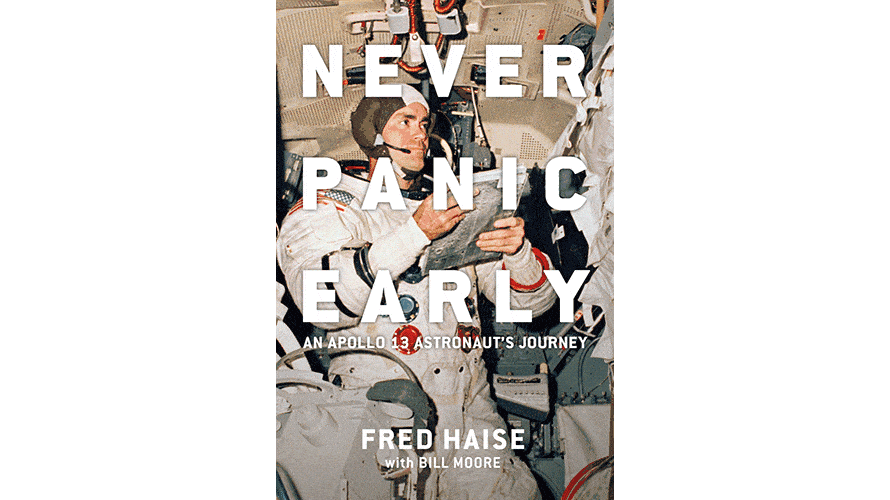Category: Nonfiction
Reviewed by: Clifford R. McMurray
Title: Never Panic Early: An Apollo 13 Astronaut’s Journey
Author: Fred Haise with Bill Moore
NSS Amazon link for this book
Format: Hardcover/Kindle
Pages: 216
Publisher: Smithsonian Books
Date: April 2022
Retail Price: $29.95/$17.99
ISBN: 978-1588347138
Of the 24 men who flew to the Moon in Project Apollo, almost all the still-surviving astronauts have published autobiographies. Fred Haise is one of the last to tell his story, and since he was the lunar module pilot on the ill-fated Apollo 13, it’s quite a tale.
Like so many other astronauts of the Apollo era, Haise had a stereotypical middle-class boyhood, growing up in a small town in Mississippi, attending a local junior college. He joined the Navy during the Korean War, and thought his best route to becoming an officer was through the Naval Aviation Cadet Program. He discovered his lifelong passion for flying on his first flight in a naval trainer. He graduated flight school too late for the war, and went on to a typical Cold War series of deployments in fighter and attack aircraft, then went to engineering school, and from there to NASA. He rubbed shoulders with Chuck Yeager at Edwards Air Force Base when he went through test pilot school there. In 1966 he was selected as a NASA astronaut, and after initial training went to work shepherding the first lunar modules through their development and engineering tests, living for months in a trailer next to the Grumman test facility on Long Island. That made him a natural choice to fly a Lunar Module (LM, pronounced “lem”) on an early Apollo flight.
He joined Neil Armstrong and Buzz Aldrin on the Apollo 8 backup crew (Apollo 8 was supposed to be Apollo 9, the second test of a LM in Earth orbit, but schedule slippages in the LM left that crew without a LM to test for several months, so NASA moved it up in the flight sequence and sent its crew on the first flight around the Moon instead). He was backup LM pilot again for Apollo 11, then got his chance to be the sixth man to walk on the Moon as LM pilot on Apollo 13. An exploding fuel cell took that opportunity away from him and he barely made it home alive. He served as backup commander for Apollo 16, and got a tantalizing second chance to walk on the Moon as commander of Apollo 19 before budget cuts cancelled that flight. So close, and yet so far from the grand prize. If he felt any understandable bitterness about that, he doesn’t let it show in this book.
He stuck with NASA through the long dry spell between the end of Apollo and the first Shuttle flight, and flew several of the glide tests (including the first one) of Enterprise, the full-scale test article that was too heavy to fly to space. But eventually his patience for another space flight ran out, and before the Shuttle flew to space for the first time, he resigned from NASA and went to work on his second career as a business executive for Grumman.
The glaring problem with this book is that it’s just too short. In some places it reads more like a telegram than a story. Here is Haise’s description of his X-15 flights: “Across those first eight months of 1965, I had also flown thirty-four flights in the X-15 program.” Huh? That’s it? Haise was a support pilot (evidently he didn’t fly the X-15 himself, although that’s not clear from this bullet point) for the first rocket plane that made it all the way to space, one of the most iconic aerospace research planes in history, and it gets just a single sentence in his autobiography? This is just one of many times that the reader wishes he wasn’t so laconic.
This book offers the facts of Haise’s career, but too little of the flavor. Not every astronaut is a natural poet or raconteur, but Haise should have given us at least 50 pages more flesh on the bones of his life story. Space fans will read this book and wish for more.
© 2022 Clifford R. McMurray
Please use the NSS Amazon Link for all your book and other purchases. It helps NSS and does not cost you a cent! Bookmark this link for ALL your Amazon shopping!



















